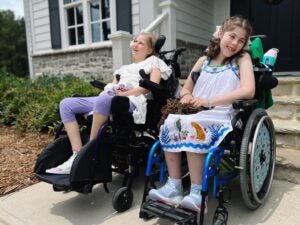June 2025 marks one year since Amelia and Makenzie Kahn received their first dose of Zebronkysen, a personalized treatment developed by University of Michigan, Michelle Hastings, PhD, for their specific mutation associated with juvenile Batten disease, or CLN3. So far, benefits of the drug have helped Makenzie walk farther on her own while Amelia is taking bites of food, including ice cream.
Batten disease is an inherited, fatal pediatric neurodegenerative disorder in which patients experience loss of abilities; from motor, communication and cognitive decline to vision loss. They also suffer from seizures, anxiety, pain, and systemic effects, such as feeding and breathing difficulties. Life expectancy is from the teenage years to early twenties.

Yael Shiloh-Malawsky, MD
The ForeBatten Foundation, a nonprofit that was founded in 2017, funds juvenile Batten disease research and support for families whose lives have been affected by the disease. In June 2024 it launched the “N-of-2” clinical trial: the first in human RNA treatment tailored to a rare mutation of CLN3. The trial is the culmination of investigational drug development efforts, from laboratory research to manufacturing to establishing a trial protocol, with UNC serving as the study site. Yael Shiloh-Malawsky, MD, a professor of neurology at the UNC School of Medicine, leads the clinical study.
This new type of personalized trial, frequently referred to as an “N-of-1” study, is a type of clinical trial that focuses on just one individual rather than a large group of people. In the case of Makenzie and Amelia, this specific treatment was created for two patients, an “N-of-2” study.
Over the past year, Zebronkysen proved in being well-tolerated and demonstrated benefit for the girls. The drug was created to help restore the function of Amelia and Makenzie’s CLN3 gene ultra rare mutation and prevent further decline.
Thriving in the face of Batten disease:
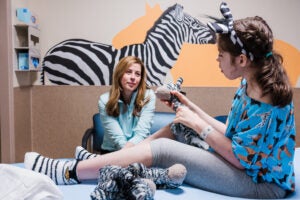
photo by: Caitlin O’Hara
Makenzie’s Progress
A step in the right direction sparked for Makenzie. From less drowsiness to walking unassisted, profound moments were seen.
“Before the trial started one of the protocols in collecting data was to measure Makenzie’s steps as she walked for two minutes without help,” said Shiloh-Malawsky. “Before the start of the drug, she walked 22 yards and did not walk the full two minutes. Six months after receiving the treatment, she walked 48 yards.”
Dystonia can be a symptom of Batten disease. It occurs when a patient experiences involuntary muscle contractions, spasms, pain and lack of mobility. Prior to start of the trial Makenzie’s motor abilities were severely affected by dystonia, her dystonia has greatly decreased after receiving the treatment. She also regained the ability to get out of bed and to get up from the floor with no assistance, which was not possible for more than two years before starting the drug trial.
Makenzie’s energy level and stamina also improved, “Makenzie used to nap a lot and be sleepy. Now, she’s more alert and awake,” said Karen Kahn, Amelia and Makenzie’s mom.
Amelia’s Progress
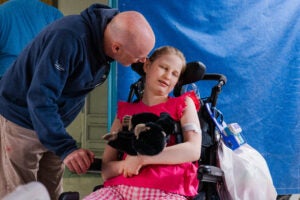
photo by: Caitlin O’Hara
Moments of joy appeared in Amelia and her smiles have become second nature.
“Before the treatment Amelia experienced sensory overload with Batten,” Karen said. “Now she tolerates noise in a restaurant and is happy. She wakes up in the morning and smiles at me.”
For the first time in about two years, Amelia started taking food and drink by mouth, like sipping water and taking bites of ice cream and yogurt. She also would normally need about two liters of oxygen to sleep at night, but now the amount has dropped to half a liter.
“Amelia also has more energy,” said Karen. “We used to use PRN rescue meds, as needed medications to help with pain, muscle spasms, and anxiety, to calm Amelia, and now we rarely need them. We still use daily medicines for the girls but not using the rescue medicines on a daily basis is a huge deal,” she said.
“We were pleasantly surprised by some of girls’ abilities appearing to come back,” said David Kahn, Amelia and Makenzie’s dad. “They didn’t last the complete three months between treatments, but there was the spike and plateau of benefits that we were very welcomed to see,” he said.
A Treatment Pathway
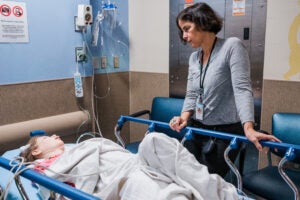
photo by: Caitlin O’Hara
The girls started off receiving an intrathecal injection of 15 milligrams of Zebronkysen in June 2024. They received additional dose every three months, and the dosage was increased with a goal of seeing the progression of the disease lessen.
“After four doses, 12 months from the first dose in June 2024, we have seen an impact that is more positive than what we expected on multiple domains,” said Shiloh-Malawsky. “Our hypothesis was that restoring CLN3 protein function would stabilize this neurodegenerative disorder and prevent further decline. We did not expect to see improvement in addition to a slowing of decline, seeing improvements is more than we hoped for.”
Throughout the year researchers observed how abilities were temporarily regained after each dose. Symptoms improved in neurologic, psychological, and general health areas, like gastrointestinal issues, which became less severe. The positive effects appeared in multiple ways, like changes in mood, ability to tolerate noisy environments, a decrease in irritability and anxiety, and improved motor abilities. Importantly, no serious adverse events related to the study drug were observed. Increasing the drug dosage has led to longer-lasting benefits.
In June 2025, the girls received the target high dose of 45 milligrams. As of now, that amount will be the girls’ maintenance dose. With the higher dose the study team hopes to achieve lasting and sustained benefits. Dr. Shiloh-Malawsky says as long as the girls continue to benefit from it, they will continue to receive the high dosage every three months.
New Possibilities on the Horizon
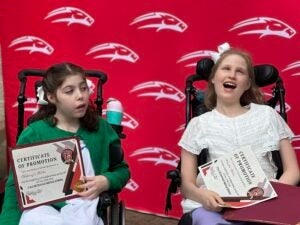
Makenzie and Amelia celebrate graduating from 8th grade.
The ForeBatten Foundation, Vanguard Clinical Rare Disease Foundation (VCRDF), a team of scientists and drug developers, and the UNC team are working to raise funding to develop treatment for other mutations that cause CLN3 Batten disease, medications that could benefit a larger patient population.
“Seeing the beneficial results from this trial puts an emphasis on the urgent need to develop similar interventions for people with other mutations in this gene of Batten disease,” said Shiloh-Malawsky.
With Zebronkysen becoming unquestionably life-changing and researchers continuing to develop individualized investigational antisense oligonucleotides (ASOs), the science is reaching new heights and potential for treating the common mutation of CLN3.
“We haven’t had any more loss of abilities while being on the drug over the last year,” said David. “That speaks to the stabilization of the decline of the disease. Zebronkysen looks very promising in our eyes.”
